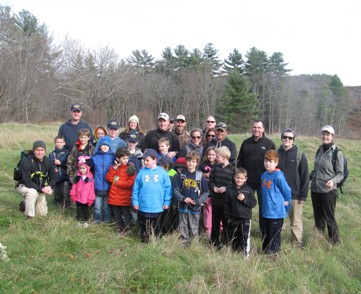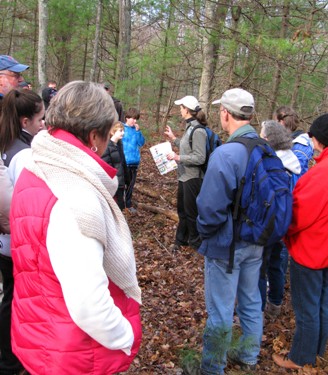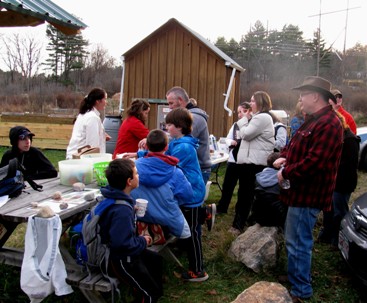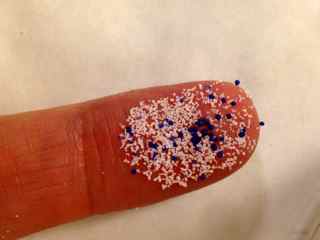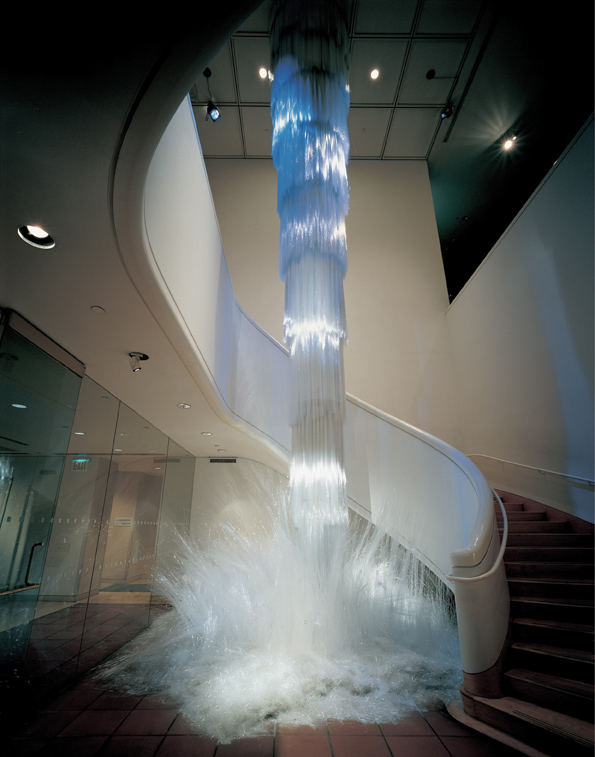|
Blackstone River Watershed Association
|
|
|
BRWA NEWS
|
Fall Hike
Over the river and through the woods to Stefans
Farm we went. On Sunday, November 15, over 60 people attended a series of
guided hikes organized by the BRWA at this 126-acre parcel of Upton Open
Space. The hikers included dozens of cub scouts and their families from
Upton Pack 132.
The hikes were offered to raise awareness of Warren Brook, a tributary of
the Blackstone River. The brook is part of a rich ecological complex that
includes fields, upland forests, streams, and wetlands. Protecting this
watershed, in part through public education, helps to protect and restore
the water quality of the Blackstone River.
Along the hike, we viewed evidence of the property's agricultural past,
including a series of seven fields, stone walls, an old cart path, an
abandoned hay wagon, an old stone dam, a stock pond, and an immense white
oak "wolf" tree probably left intact over generations of farming to be
used as shade for cattle on hot summer days.
We immersed ourselves in the natural features of Stefans Farm including
beech groves, quartz outcroppings, nesting areas of state-listed turtles,
trees ripped open by insect-seeking woodpeckers, beaver dams,
still-flowering witch hazel, and an abundance of acorns that rolled under
our feet like marbles. The scouts especially enjoyed dispersing the white
fluffy seeds of the milkweed plants that grow abundantly in the fields.
As we hiked through the fields and woods, we gained a better understanding
of the management challenges facing the Upton Land Stewardship Committee.
As soon as farm fields stop being mowed or grazed, invasive plants move
in. Sunday's hike took us past multiflora rose, Japanese barberry, glossy
buckthorn, winged burning bush, autumn olive, bush honeysuckle, Norway
maple, and the dreaded oriental bittersweet.
At hike's end, everyone enjoyed cider, hot cocoa, and home-baked goods.
People interested in assisting with stewardship of Stefans Farm should
email
uptonlandstewardship@charter.net. Watch the
BRWA's website for future events
including hikes, paddles, and our annual EarthDay Cleanup.
Photos by Pieter DeJong.
top
|
Honoring a Blackstone Advocate: Correction
In the previous issue (November 2015), we incorrectly
identified Val Stegemoen as Park Manager at the Blackstone River and Canal
State Park at River Bend Farm (RBF) in Uxbridge. For the past 5 or 6 years,
Val served for DCR as Field Operations Team Leader for the Blackstone Complex,
working not only at RBF but also at Purgatory Chasm, Upton State Forest, and
Douglas State Parks and Forest.
top
|
|
CALENDAR OF EVENTS
|
December 13 is National Violin Day.
If you are lucky enough to know how to play violin, invite some friends over
for an impromptu performance. If you can't play, maybe this is the time to
learn something new! If you are not quite ready to become a virtuoso, at
least find a recording of Vivaldi's Four Seasons to listen to. It will be
the best 42 minutes of your day!
|
|
12/6
|
Hike to Goat Hill Lock.
1:00-2:30 p.m. Blackstone River and Canal State Park.
Uncover interesting stories in stone and follows changes in the landscape
along the Blackstone Canal. Meet at RBF Visitor Center. Info: 508-278-7604.
|
|
12/7
|
Trout Unlimited Central Mass Chapter Monthly Meeting.
6:00 -9:00 p.m. Auburn Sportsman's Club. 50 Elm Street, Auburn, MA.
info
|
|
12/12, 21, 28
|
Brown Bag Along the Blackstone.
12:00-1:00 p.m. Blackstone River and Canal State Park,
Uxbridge. Bring a lunch, watch an episode or two of “Along the Blackstone”,
an award winning series of videos by the NPS, and take an optional canal walk
at 1:00. RiverBend Farm, Uxbridge. Info: 508-278-7604.
|
|
12/13
|
13th Annual Decorate a Tree for Wildlife and Grassland Hike.
2:00 p.m. West Hill Dam. Meet at Dam office.
Uxbridge. Info: 508-278-2511.
|
|
12/16
|
Blackstone River Watershed Council Monthly Meeting.
6:30pm - 8:30pm. Lincoln RI.
info
|
|
12/20
|
Solstice Sunrise Walk.
7:00 - 8:00 a.m. Blackstone River and Canal State Park.
Celebrate the lengthening of days by taking a guided sunrise walk and enjoy
the landscape of the fields, canal and river at its seasonal best.
Info: blackstone.heritage@state.ma.us
or 508-278-7604.
|
|
12/22
|
Winter Solstice!!!!!
|
|
1/1
|
First Day Hike.
1:-00 - 3:00 p.m. Blackstone River and Canal State Park.
Celebrate the new year with a walk along the canal, view the Blackstone River
and signs of winter wildlife. Warm up after with cocoa and conversation.
Info: 508-278-7604.
|
|
1/4
|
Winter Hike
Grafton Land Trust. Location and time TBA: see our
Facebook page or
email info@graftonland.org.
|
|
1/4
|
Trout Unlimited Central Mass Chapter Monthly Meeting.
6:00 -9:00 p.m. Auburn Sportsman's Club. 50 Elm Street, Auburn, MA.
info
|
|
1/20
|
Blackstone River Watershed Council Monthly Meeting.
6:30pm - 8:30pm. Lincoln RI.
info
|
|
1/28
|
BRWA Board Meeting.
6:45 p.m. to 8:00 p.m. 287 Oak St., Uxbridge.
info
|
top
|
THINK GLOBAL, ACT LOCAL
|
Microbeads Threaten our Waters and Health
They are tiny; they are used by millions of people
every day; and they are wreaking havoc in our freshwater and marine
ecosystems. Microbeads, typically less than two millimeters in size, were
patented 40 years ago but have only recently become a staple in consumer
products. These highly durable bits of plastic are used in a wide range of
personal care products including toothpaste, skin exfoliants, and makeup
where they provide a texture that is gritty as needed yet smoother than that
provided by pumice, apricot shells, and other natural alternatives. The
most common plastics used in the manufacture of microbeads include
polyethylene (PE), polypropylene (PP), polyethylene terephthalate (PET), and
polymethlyl methacrylate (PMMA).
Due to their size and durability, microbeads can pass through wastewater
treatment plants and enter waterbodies unchanged. Research studies in the
Great Lakes have found concentrations of up to 1.1 million beads per square
kilometer. And NYU researchers measured a rate of 80,000 beads per day
passing through each wastewater treatment plant. In their study, it was
estimated that eight trillion microbeads are flushed into the waters of the
United States on a daily basis. Even worse, that represents only one percent
of microbeads that get washed down drains. The remaining amount becomes
lodged in treatment plant sludge that may be used to fertilize agricultural
areas—a known source of contaminated runoff.
So what's the harm of these tiny plastic beads entering our streams, rivers,
and oceans? There are two issues. First, they have a large relative
proportion of surface area that allows them to act as sponges, absorbing
PCBs, pesticides, flame retardants, and other persistent toxins. Second,
they can be mistaken as food and taken in by plankton and fish. These
organisms are then deprived of essential nutrients as well as becoming agents
of bio-magnification for the toxins. Moving throughout the food web, other
aquatic species and the humans that consume them can develop cancers and
other ailments as they metabolize the compounds.
Researchers, environmentalists, and political leaders are asking what can be
done to stop our oceans from turning into more of a toxic plastic soup than
it already has. Unlike many other forms of toxins, plastic microbeads are
considered a relatively controllable problem that we can solve. Many states
and countries are considering, or have adopted, legislation to combat the
microbead crisis. The Netherlands, Canada, Australia, and Hong Kong all
advocate an end to their use in cosmetics and other personal care products.
Illinois was the first U.S. state to ban the manufacture and sale of products
containing microbeads. Many states have enacted legislation that only allows
biodegradable beads. However, the extent to which the plastic will break
down not just in the lab but also in natural aquatic systems (lake beds, for
example) has not been demonstrated. The U.S. Congress rejected a proposed
bill banning microbeads in 2014, but is considering a reintroduced one this
year (H.R. 1321).
What can consumers do?
- Read labels of products before purchasing them. Look for
polyethylene, polypropylene, polyethylene terephthalate or polymethyl
methacrylate.
- Support companies like L'Oreal, Johnson & Johnson, Adidas, The Body
Shop, and Unilever that have pledged to phase out plastic microbeads from
their products.
- Check out this list:
http://www.beatthemicrobead.org/en/product-lists.
- Download the free "Beat the Micro Bead" app
here.
- Send back your unused products with microbeads and let the company
know why you won't be purchasing it any longer.
- Learn more microbeads at the following websites:
top
|
|
BE GREEN
|
 Winter Lighting is all a buzz!
Winter Lighting is all a buzz!
Many cultural traditions this time of year, including
winter solstice celebrations, involve lighting candles. Consider using
bees-wax candles or soy-based ones in place of standard wax candles. The
paraffin used in conventional candles is derived from petroleum, and is
further treated with chemicals before reaching retail stores.
Bees-wax candles, however, in addition to not releasing this
petroleum/chemical mix into your home or work environment, actually help to
clean the air of dust particles and other potential allergens according to
some people. So even though we have to wait until next summer to see bees
buzzing around our fields and gardens, we can still keep them close by,
helping us keep the darkness of winter at bay.

top
|
|
REFLECTIONS
|
“It is not half so important to know as to feel.” Rachel Carson
Steven Tobin is an artist who works in steel, bronze, clay, and glass. He
has a series of pieces he refers to as waterglass. The ability of something
as fragile as glass to capture the power of moving water is what makes this
art. Millions of capillary tubes are repurposed to create these sculptures.
top
|
Views & opinions expressed in linked websites do not necessarily
state or reflect those of the BRWA.
|
|
Your input is crucial to this eNewsletter. If you have a local
watershed-related story, information of interest to our subscribers, or
comments about this publication, drop an email to the editor.
The Blackstone River Watershed Association (BRWA) has a mission to
engage, educate, and advocate for improved water quality in the Blackstone
River Watershed; its objectives are to:
- Engage the public in watershed stewardship activities,
- Educate members, supporters, and residents on watershed protection strategies, and
- Advocate to local residents, community leaders, non-profit partners, and
state regulators to take actions that will help to ensure our waterways continue
to provide healthy habitat and enjoyable recreational opportunities.
The BRWA eNewsletter is published monthly by the Blackstone River Watershed
Association. BRWA is a 501(c)(3) non-profit organization.
Editor: Susan Thomas susan.thomas@thebrwa.org
Mailing address: BRWA, 271 Oak Street Uxbridge, MA 01569
Phone: 508-278-5200 Web: www.thebrwa.org
Click here for back issues.
|
|

